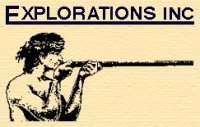Trujillo & Chiclayo tour. Note: We operate the 3Day/2Night program below with private guide service and can customize itineraries for 2 or more participants. See below for options on a 4 Day, and 7 Day private touring of the North Coast.
Day 1: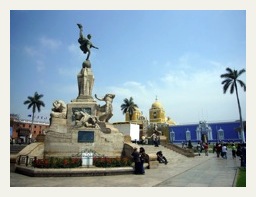
Morning transfer to Lima airport for flight to the colonial city of Trujillo on the northern coast of Peru. Upon arrival in Trujillo, you are met at the airport and the local staff personnel will assist with your luggage and then transfer you into town to the upscale Costa Del Sol Hotel for two overnights. There you have guided City Tour in Trujillo, including visits to the Moche archaeological sites of Huaca del Sol and Huaca de la Luna.
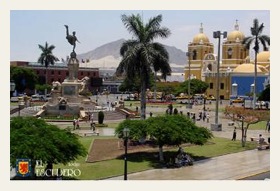 First you explore in the historic center of the colonial city of Trujillo for its main plazas, grand architecture, cathedrals and museums. Besides nearby incredible colonial buildings and archaeology sites, due to its geographic location, Trujillo is also known for its seafood, nearby beaches and surfing. Trujillo is also known for quality leather goods (particularly shoes), woodcarvings and replicas of Precolombian ceramics.
First you explore in the historic center of the colonial city of Trujillo for its main plazas, grand architecture, cathedrals and museums. Besides nearby incredible colonial buildings and archaeology sites, due to its geographic location, Trujillo is also known for its seafood, nearby beaches and surfing. Trujillo is also known for quality leather goods (particularly shoes), woodcarvings and replicas of Precolombian ceramics.
After lunch and rest at one of the many fine restaurants in the downtown we will drive southeast of the city to visit the Moche archaeological sites of Huaca del Sol and Huaca de la Luna.  The countryside in the province of La Libertad was the land where the ancient Mochica culture chose to build up its most important ceremonial centres: The Huaca del Sol and the Huaca de la Luna. Located only 8 km away from the city of Trujillo, these impressive monuments are more that 1,500 years old. The Huaca or Temple of the Sun functioned as an administrative and political center. It is a staggered pyramid of approximately 43 meters high that was built with around 70 million adobe brick and was the largest pre-Columbian adobe structure built in the Americas. The Huaca de la Luna or Temple of the Moon is located 500 meters away from the Huaca del Sol. This construction was built for ceremonial purposes and it is formed by six superimposed temples built during different periods of the Mochica culture. Its polychrome big walls, on which they represented the Mochica divinity known as Ai-Apaec (Slaughterer God) are remarkable since they are very well preserved. It is thought that multiple human sacrifices were held to honour this god, rituals that have been captured in other elements of the Mochica iconography.
The countryside in the province of La Libertad was the land where the ancient Mochica culture chose to build up its most important ceremonial centres: The Huaca del Sol and the Huaca de la Luna. Located only 8 km away from the city of Trujillo, these impressive monuments are more that 1,500 years old. The Huaca or Temple of the Sun functioned as an administrative and political center. It is a staggered pyramid of approximately 43 meters high that was built with around 70 million adobe brick and was the largest pre-Columbian adobe structure built in the Americas. The Huaca de la Luna or Temple of the Moon is located 500 meters away from the Huaca del Sol. This construction was built for ceremonial purposes and it is formed by six superimposed temples built during different periods of the Mochica culture. Its polychrome big walls, on which they represented the Mochica divinity known as Ai-Apaec (Slaughterer God) are remarkable since they are very well preserved. It is thought that multiple human sacrifices were held to honour this god, rituals that have been captured in other elements of the Mochica iconography.
Day 2:
After breakfast is a guided tour of the ancient Chimu culture’s ruins of Chan Chan, claimed to be the largest pre-Columbian city in the Americas and the largest mud-brick city in the world. The ancient Chimú kingdom (700-1400 AD) founded their capita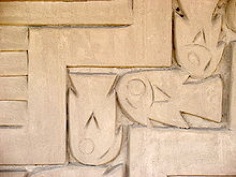 l by the banks of the Moche River in the department of La Libertad and called it Jang-Jang, which in the ancient Mochica language means "sun-sun".
l by the banks of the Moche River in the department of La Libertad and called it Jang-Jang, which in the ancient Mochica language means "sun-sun". 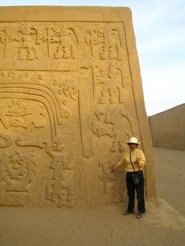 The city was the urban center of a vast regional state which covered half of the Peruvian coast, stretching from Tumbes on the Ecuadorian border down as far south as Lima. All roads branched out from Chan Chan.
The city was the urban center of a vast regional state which covered half of the Peruvian coast, stretching from Tumbes on the Ecuadorian border down as far south as Lima. All roads branched out from Chan Chan.
Later is a visit to Huanchaco Beach, famous for its fishermen’s use of the caballitos de totora, which are lightweight boats made of totora reeds that have been used for fishing in the ocean since the time of the Mochicas and Chimús. There, you can also enjoy exquisite seafood. Later you transfer by bus to the historic city of Chiclayo, also famous for its fine cuisine. Reception at the station and transfer to the Casa Andina Select Chiclayo (formerly the Gran Hotel Chiclayo) for the overnight. (B)
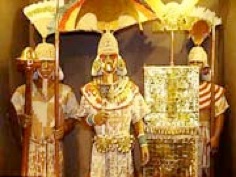 Day 3:
Day 3:
After breakfast is a guided tour of the Lord of Sipan archaeology museum, "Tumbas Reales del Senor de Sipan". In the fourth century AD, the Moche people buried one of their greatest warlords. He was buried with his head pointing south, his nose and ears covered with gold relics and his feet clad in silver. To accompany him, his subjects sacrificed women, children and llamas, while the finest warriors of the era accompanied their overlord on his voyage to the Afterlife. In 1987, a team of archaeologists led by Walter Alva found the skeleton of the Lord of Sipán 29 km from the city of Chiclayo in the department of Lambayeque, on Peru's north coast. It was hailed as one of the most important archaeological finds of the century. The structure found in Sipán is made up of three pyramids, one of which contained the warrior-priest accompanied by the bodies of his followers. After spending years on exhibit in the Americas, Europe and Asia, the treasures of the Lord of Sipán are now on display at the Museum "Tumbas Reales de Sipán" in the town of Lambayeque.
 Later is a visit to Tucume for The Valley of the Pyramids, comprised of dozens of mud-brick pyramids formed around the sacred mountain of La Raya. There, you will see more than twenty adobe pyramids, all approximately forty meters high, that belong to the Lambayeque culture and which are nestled in an area full of wildlife and abundant vegetation. In the evening you transfer to the airport for flight to Lima for late night flights out. You may also add an reception in Lima and transfer into town to the colonial-style, Hotel Antigua Miraflores for the overnight. (B)
Later is a visit to Tucume for The Valley of the Pyramids, comprised of dozens of mud-brick pyramids formed around the sacred mountain of La Raya. There, you will see more than twenty adobe pyramids, all approximately forty meters high, that belong to the Lambayeque culture and which are nestled in an area full of wildlife and abundant vegetation. In the evening you transfer to the airport for flight to Lima for late night flights out. You may also add an reception in Lima and transfer into town to the colonial-style, Hotel Antigua Miraflores for the overnight. (B)
SERVICES:
Airport transfers and transportation as listed (including bus between Trujillo and Chiclayo)
All accommodations as listed (Two nights hotel)
Meals as listed (Two breakfasts and one lunch)
Guided tour as listed
NOT included are Peru flights or airport taxes, and gratuities to guides.
ADDITIONAL DAY OPTION
Re the transfer between Trujillo and Chiclayo, if you can add a day, we can substitute private guide/driver instead of the bus between the cites. Budget and extra $350 / per person including extra overnight in Trujillo and private touring. This would allow you to have an revised Day 3 of:
After breakfast, we depart Trujillo and head up the coast to visit the El Brujo Archaeological Complex and its museum and learn about the Lady of Cao. Also in the area, Chicha de Jora, an alcohol based corn beer is available and the chicha of Magdalena de Cao, near El Brujo, has been rated the best in Peru.
In route we can stop to see the small ruins of San Jose De Morro outside of Chepen. It is one of the many important cemetery sites and regional ceremonial centers of the Moche society and subsequent cultures in the Jequetepeque Valley.
In route, we may also make a stop at the site of Hauca El Pueblo, location of the rich Moche burial of an elite called the Lord of Ucupe. The ancient ruler was also nicknamed the "king of bling" because of the large amount gave goods and his regalia. Recent excavations of the 1,500-year-old tomb uncovered 19 golden headdresses, various pieces of jewelry, and two funerary masks, as well as skeletons of two other men and a pregnant woman. A most excellent overview of the Moche can be found at: http://www.utexas.edu/courses/arh400/lectures/390/weblec.htm
When then continue north along the coast to the historic city of Chiclayo, also famous for its fine cuisine and colonial architecture. We overnight at the Chiclayo Costa Del Sol for two overnights.

PERU NORTH COAST: 7 DAY TOUR
For those looking to explore this incredible area more in-depth, we offer a 7 day tour from Lima with private guide and transportation. This allows you to explore at your own pace the ancient world of the Caral, Chavin, Wari, Chimu, Sechin, Moche cultures. 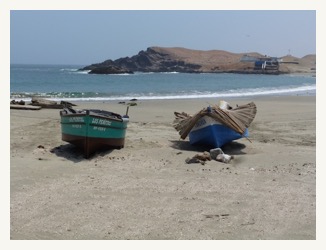
In this region of delicious cuisine and Spanish-colonial towns, you may visit such places as: the Caral ruins, Lomas del Lachay National Reserve, Paraíso Lagoons Bandurria ruins, Aspero and Bandurria ruins, Barranca, Fortaleza de Paramonga, Pativilca, El Castillo de Huarmey ruins of the Wari, Sechín ruins, Casma Regional Museum for an overview of the Chavin, Wari, Chimu and Sechin cultures, Sechin Alto, Tuquillo Bay, Chankillo, Trujillo, Huaca del Sol and Huaca de la Luna ruins, Mercado de Brujos, Chan Chan, Huanchaco Beach, El Brujo Archaeological Complex and Lady of Cao Museum, San Jose De Morro, Hauca El Pueblo, Chiclayo, Sipan archaeology site of Huaca Rajada, regional museum of the "Tumbas Reales del Senor de Sipán”, Bruning National Museum, and more.

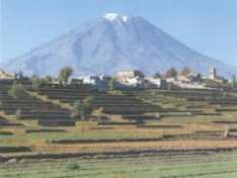
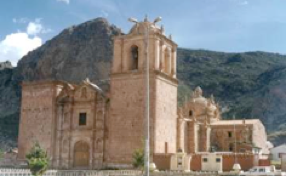
TRUJILLO
Trujillo, the capital of the department of La Libertad, is known as the city of eternal spring because of its blessed climate and festive atmosphere. The area was inhabited by two important, ancient Peruvian civilizations, the Mochica and the Chimú, and later, it became an important vice royal city. A friendly, colonial city and at the same time one of the main economic and cultural centers of northem Peru. What is more, it is the capital of the marinera dance and caballo de paso (a fine breed of horses). It was the center of the Chimú culture (1100-1400 AD), whose Chan Chan citadel is the largest pre-Hispanic mud-brick construction in the Americas. Trujillo was founded in 1534 as one of the main cities in the vice-regency -The old quarter features many fine colonial buildings such as the Cathedral, the El Carmen monastery and churches and mansions which symbolize the beauty and architectural harmony of the city. Visitors can take in an older style of architecture on the city`s outskirts, where the remains of a pre Hispanic civilization still rear above the green fields and desert sands. The Chan Chan citadel, the El Brujo complex and the temples of the Sun, the Moon and the Dragon, amongst others, are evidence of highly advanced northern civilizations. 
Beaches near Trujillo are ideal for visitors, not just because of the superb local seafood, fresh caught, or the cool sea breeze, but also for the opportunities for adventure sports and contact with tradition. Huanchaco is a picturesque fishing cove where one can find the ancient craft that appeared on Mochica pottery and friezes at Chan Chan. The caballitos de totora, rafts woven from the totora reed in an art that has been handed down over generations. Similar skill is shown by the surfing crowd, which year after year gather in the port of Malabrigo. A surfing championship is staged here every March and local beaches feature the world`s longest waves.
Above all, Trujillo is the land of the marinera, and the townspeople hold the National Marinera Contest every March In September the streets and houses are festooned with decorations to receive a procession of floats, competitions and parties. This is the International Spring Festival, which celebrates the arrival of spring in Peru.
CHAN CHAN
The ancient Chimú kingdom (700-1400 AD) founded their capital by the banks of the Moche River in the department of La Libertad and called it Jang-Jang, which in the ancient Mochica language means sun-sun.
Chan Chan, which spans an area of 20 square km, is the largest mud-brick citadel dating back to the pre-Hispanic era. The Chimú architects used materials which enable the citadel to blend in with the sandy coasts such as mud, clay, pebbles, wood, reeds, straw and cane to built it. The complex is made of many cities within a city. Each one has its own single entrance and leads down a corridor that opens into othe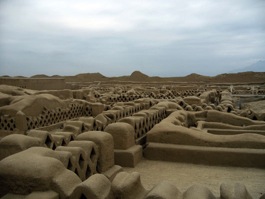 r passageways lining walls and buildings. Featuring some marvelous rectangular architecture: such as inner patios, residences, administrative buildings, temples, platforms and storehouses. The walls are decorated with haut-relief friezes done in geometric and animal figures. The T-shaped plaform that houses the king´s burial chamber is the most important construction in the complex. The citadel is surrounded by outlying quarters which houses the kingdom's producers and servants.
r passageways lining walls and buildings. Featuring some marvelous rectangular architecture: such as inner patios, residences, administrative buildings, temples, platforms and storehouses. The walls are decorated with haut-relief friezes done in geometric and animal figures. The T-shaped plaform that houses the king´s burial chamber is the most important construction in the complex. The citadel is surrounded by outlying quarters which houses the kingdom's producers and servants.
The separate cities today have been given the names of the archaeologists who studied them (Rivero, Tschudi, Bandelier, Uhle and Tello). The Rivero city was the seat of Minchancamán, the last of the Chimú rulers, who was captured by the Incas and taken to Cuzco, according to the Spanish chroniclers. The city was the urban center of a vast regional state which covered half of the Peruvian coast, and stretched on from Tumbes to Lima.
CHICLAYO
Chiclayo is a part of Peru where the tropical sun, desert oases and fresh sea breeze come together. Legend has it that the god Naylamp sailed here with a vast retinue thousands of years ago to find his empire. In fact, many ancient civilizations saw the strategic advantage of controlling this region. Today, it is a major business hub in northern Peru, where routes come together from the coast, highlands and jungle. Chiclayo is the capital of the department of Lambayeque, which gave rise to the Mochica culture from the first to the seventh century AD.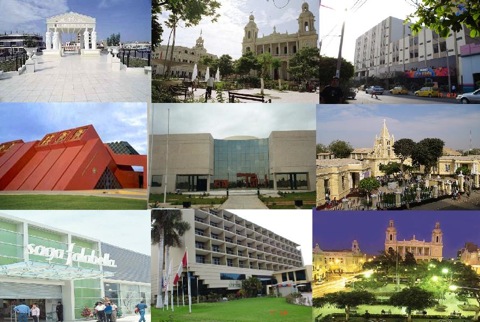
Near the town of Sipán, 35 km (22 miles) from Chiclayo, lies Huaca Rajada, a complex where archaeologists discovered the tomb of the Lord of Sipán, a high-ranking leader whose body was accompanied by gold relics and jewelry. The treasure trove is on exhibition at the brand new museum: Museo Tumbas Reales de Sipan.
Another major complex is that of Túcume, also known as the Valley of the pyramids, because there are 26 of them. Visitors can take in archaeological sites and the natural landscape, as well as experience folk healing and a culture interchange in general, thanks to the active participation of the community in the preservation of their natural and cultural heritage.
Chiclayo also boasts of the finest cooking in northern Peru, serving dishes such as arroz con pato (duck served with rice) and the local variation of cebiche (raw fish marinated in lemon juice). The city celebrates the festival of Santisima Cruz de Chalpón in February. This is a good time to visit nearby Pimentel, a modern beach resort which provides opportunities for water sports such as surfing. One can also watch how the local fishermen still breast the waves with the caballitos de totora, the reed rafts that have been used along the north coast for thousands of years.
GASTRONOMY
* Cebiche. Raw fish marinated in lemon juice, onion and aji chilli pepper.
* Tortilla de raya. An omelette with salt-dried ray.
* Chinguirito. Cebiche made from from shredded salt-dried fish.
* Seco de cabrito con frijoles. Stew of tender kid marinated in maize beer.
* Arroz con pato a la chiclayana. Duck in dark beer and cilantro.
* Chirimpico. A stew made from marinated goast offal.
ROYAL TOMBS OF SIPAN 
In 1987, a small group of Peruvian archaeologists led by Dr Walter Alva discovered the tomb of an important Moche governor, at Huaca Rajada (at 21 miles southeast of the city of Chiclayo), complete with all his attire, riches and his symbols of power. The discovery was world news and is considered as important as the discovery of the tomb of the Pharaoh Tutankhamon in 1922. The Lord of Sipan died some 1770 years ago. As sovereign, he was considered a semigod. He lived for about 40 years and was 5.5 feet tall. His rich robes and accessories included necklaces, breastplates, ear spools, nose rings, helmets, bracelets and sceptres, mostly in a combination of gold and silver.
Of exceptional beauty are the three pairs of turquoise and gold ear ornaments showing ducks, deers and the Lord of Sipan himself, as well as the breastplates of delicately threaded shell beads. The necklace contains gold spheres and another of huge peanut shells - ten of which were in silver, ten in gold. The scepter is decorated with an inverted gold pyramid with scenes of human sacrifice. There are also objects in copper, spondyllus shells and semiprecious stones. Most of the pieces are decorated with symbols. Shortly after the discovery of the Lord of Sipan's tomb, Alva and his team found two more tombs, of a Priest and the Old Lord of Sipan. The importance of this discovery and the need to provide an appropriate place to house the finds, led to the construction of the Royal Tombs of Sipan Museum, which opened in 2002 in the city of Lambayeque (9 miles from Chiclayo).















